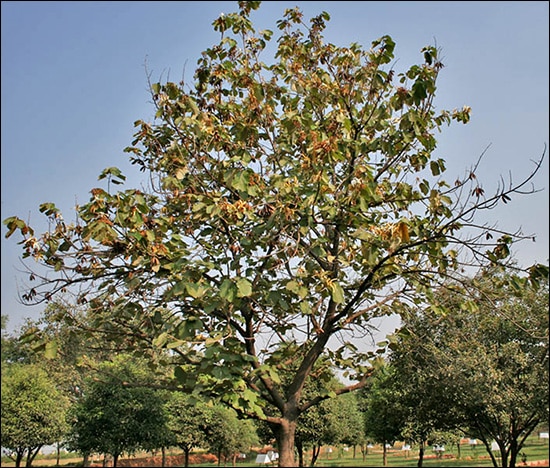Muchkund / Bayur Tree (Pterospermum Acerifolium)- Ayurvedic Properties, Effects On Doshas & Dosage
Description
The knowledge of Ayurveda was passed by sages orally In India to their students in different places in the form of conferences or seminars. They have discussed every herb, every disease, and every milestone of the human. According to Ayurveda, every person is influenced by certain elements that are present on the earth in the form of Panchamahabhutas and tridoshas. Panchamahabhutas are space, air, fire, water, earth, and tridoshas are Vata, pitta, and Kapha. These all must be in a balanced state so our body is always set to keep away the diseases. Many persons have the Prakriti consisting of two doshas like vata-pitta or Kapha- pittaj which means these persons have both dosha properties. These Prakriti are influenced by our dietary habits and when it gets vitiated we can develop various diseases. In this article writing, we are going to discuss the one such herb that directly acts on our doshas and helps our body to maintain the balance between Prakriti and doshas.

General Information
Muchkund is an evergreen tree, its botanical name is Pterospermum acerifolium and it belongs to the family of Sterculiaceae, and is widely famous for its English name Bayur tree, Maple Leaved Bayur tree, Dinner Plate Tree. it is known worldwide by different names like in Hindi – Muchakuna, In Telugu – Lolugu, In Bengali – Muchakund Chompa, and in Sanskrit, it is named Chitraka, kshatra Vruksha, Prativishnuka, Lakshmanaka, and many more. its flowers bloom from the month of march to July and its fruits are ripened after one year of flower blooming time.
Special Note About This Plant
This plant grows in eastern and southern or western parts, especially in West Bengal, Orissa, Assam, kokan, or northern areas.
- Bhavprakash Nighantu has mentioned this herb in Aushadhi Varga and is said to be beneficial in certain diseases.
- Raj nighantu has also put his eyes on this herbal medicine and said this herb is a beneficial plant in ulcers, skin-related conditions, and in vitiation of doshas.
Ancient Verses
Shloka – 1
मुचकुन्दः क्षत्रवृक्षश्चित्रक: प्रतिविष्णुक:।
मुचकुन्दः शिर:पीड़ापित्तास्रविषनाशनः।।
Reference – Bhavprakash Nighantu / Pushpa Varga
Interpretation of Shloka – Muchkund, kshatravriksh, chitrak, prativishnnuk are the synonyms. This helps to pacify the Headache, increased pitta dosha, and bleeding disorders, and is used to rectify the Poisoning.
Shloka – 2
मुचकुंदो बहुपत्रः सुदलो हरविल्लभ: सुपुष्पश्च ।
मुचकुन्दः कटुतिक्तः कफकासविनाशनश्च कण्ठदोषहर:।।
त्वगदोषशोफशमनो व्रणपामाविनाशनश्चैव।
Reference – Raj Nighantu / Karveeradi Varga
Interpretation of Shloka – Muchkundo, bahupatro, sudala, harivallabh, supushpa are the synonyms. Mukunda is pungent and bitter in taste, it quells Kapha, and dosha and relieves cough, alleviates throat and skin infections, and edema. It heals wounds and eczema.
Systemic Classification
- Botanical Name – Pterospermum acerifolium
- Family – Sterculiaceae
- Genus – Pterospermum
- Species – P. acerifolium
Synonyms
- Bahupatra – has numerous leaves
- Supushpa – having beautiful flowers
- Sudala – having beautiful petals
- Haripriya – flowers are liked by Lord Vishnu
Habitat
- This is a large tree, of 30 metres in height with grey-colored bark and is having a rusty appearance on its new and youngest part.
- Its leaves are rectangular or orbicular, obovate to ovate in shape, a round of 10 to 40 cm in length and are having toothed and irregular lobes on the leaves surface.
- Flowers are solitary of white in colour, having bracts lacinate.
- Sepals are linear-lanceolate, 8-12 cm long with broadness of 1-2cm.
- Pterospermum is a genus of tropical trees and shrubs. It gives fragranced nocturnal white colour flowers that grow in fascicles that are axillary.
- Capsules are stalked, oblong, and woody as well as brown tubercled in appearance.
- It has a different variety named Pterospermum Canescens which some people call as muchkund and some say karnikar. This is almost the same as the Muchkund properties.
Ayurvedic Properties
- Rasa (Taste) – Katu (Pungent), Tikta (Bitter), Kashaya (Astringent)
- Guna (Quality) – Pichil (viscous)
- Veerya (Potency) – Somewhat Ushna (Hot)
- Vipaka (Post digestive effect) – Katu (Pungent)
- Karma (Action) – Balances all the doshas
- Projyang (Part used) – Flowers are used
Effects On Doshas
- It balances all the doshas like Vata, Pitta, and Kapha.
- Due to its kashaya ras, it is helpful in pacifying Pitta and Kapha dosha and due to its ushna gunna it is helpful in pacifying the vata dosha.
Practical Uses
- This herb is used mainly in the pacification of vata and pitta-related diseases.
- Its external application is useful in headaches and bleeding piles, and in various viral infections.
- This is very effective in pain-related symptoms in various vataj diseases.
- In most blood-related disorders, this herb is used, due to its vata and pitta shamak diseases, to clot in bleeding piles.
- Its flower powder can be used in the mixture of ghee and sugar to control the bleeding piles.
- In respiratory diseases, this is helpful in managing the cough and hoarseness of the throat.
- It can be used in different types of poisoning cases.
- This is very effective in skin-related diseases because of its pitta pacification property.
Dosage
The powder of the flower or bark can be used in the dosage of 3 to 6 grams.
Ayurvedic Products
-
Himanshu tail



